World War 2 Navy
part 3
Contents
Part 3
Aircraft Carriers
Submarines
Small Boats
PT Boats
Amphibians
Part 1: WW2 Weapons
Part 2: WW2 Aircraft
The weapons revolution and the associated platforms transformed the world's navies. Nothing like a war to stimulate scientific interest.
World War 2 was a wake up call for the United States to build a new war machine despite the isolationist mind set of many policy makers and elected officials.
The stimulation was most acute after December 7, 1941, a date memorializing the Japanese surprise attack on Pearl Harbor.
Some countries, particularly those who would become mortal enemies of democratic institutions, used the peaceful years after World War 1 to transform their military services utilizing the newest technologies and scientific advances.
Aircraft Carriers World War 2 Weapons and the Navy
To an island nation like Japan, it was a no brainer that a modern navy was necessary to dominate what they euphemistically called The Greater East Asia Co-Prosperity Sphere. On the European side of the world, Hitler's Germany hungered for expansion, but knew they would be thwarted----as they were in World War 1----by the powerful British fleet. Both these dictatorships geared their industrial sectors to convert to a war footing. In Germany's case, it was accomplished in contravention of its treaty obligations of 1919.
As for
Japan, their build up did not surprise many officials in Washington who
had believed war with Japan was inevitable since the days of Teddy
Roosevelt earlier in the century. As far back as 1936, Admiral
Isaruko Yamamoto, the architect of the Pearl Harbor attack, led a plan
to build more aircraft carriers than battleships.They launched the
Hosho, the first specifically designed carrier (not converted) in 1922. Coincidentally, the Japanese had signed a treaty with the British in that year limiting the amount of carriers to be built in the future.
World War 2 Weapons and the navy
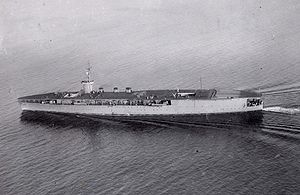
There was a lone voice in Washington D.C.,in 1925, insisting that the Army and Navy Departments were an ""almost treasonable administration of the national defense". Billy Mitchell, World War 1 air ace, levied this criticism at the government because they were fixated on building battleships instead of aircraft carriers. He insisted that battleships were vulnerable to bombing. A year later he was convicted of insubordination. And eight years later (1934) the U.S. did build its first all purpose carrier --- USS Ranger.
World War 2 Weapons and the navy
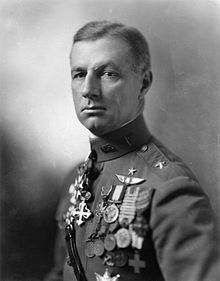 |
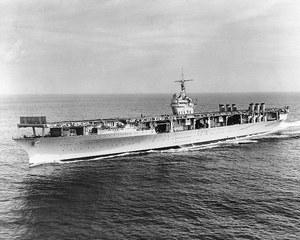 World War 2 Weapons and the Navy |
However, forewarned was not necessarily fore-armed. In 1939, both the British and American navies were, at best, prepared to fight with World War 1 technology. The United States would go to war in 1941, with only four all purpose carriers to face 10 Japanese aircraft carriers. The United states navy still had a passion for battleships, but in a concession to modernization, with cost cutting in mind, they converted 6 cruisers to carrier status.
The Pacific Ocean without
sufficient American land air bases, some of which were lost to the
Japanese (Henderson Field in the Philippines), learned the hard way the
significance of aircraft carriers. However, their enemies had not
recognized the resourcefulness of industrial America that produced over
100 carriers by wars end. These included fleet carriers, light carriers
and escort carriers.
On December 7, 1941, the Japanese, with 33 ships, struck the American navy's 86 ships anchored in Pearl Harbor (Oahu,Hawaii) . The Japanese planes were launched from 6 aircraft carrier. They bombed and torpedoed 8 battleships, but all but two (USS Arizona and USS Oklahoma) were repaired and fit for service. American dead 2407, including 60 civilians, and Japanese dead, 64.
World War 2 Weapons and the Navy
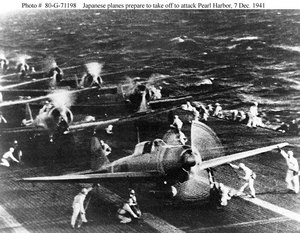
Fortunately, the U.S.
Pacific carrier fleet was at sea and escaped the attack (Lexington,
Saratoga and Enterprise). On that day, U.S. radar spotted 189 planes and
assumed they were off the carrier, USS Enterprise. Wrong! It was the enemy.
A year earlier, November 11, 1940, a British fleet operating in the Mediterranean Sea launched their torpedo planes from their carriers against the heart of the Italian fleet. The planes struck 3 battleships amongst other ships and all but destroyed the Italian Mediterranean fleet.
The Allies would quickly learn the value of aircraft carriers and the prescience of Billy Mitchell. Belatedly, and posthumously, his service to the nation was recognized by President Franklin Roosevelt.
The aircraft carriers would be central to the American campaign to regain or hold the chain of Pacific islands that ultimately brought United States forces within 900 miles of the Japanese islands. Before their land forces subdued the Japanese on Okinawa, The USS Hornet had penetrated to within 800 miles from Japan. On April 18, 1942, 16 B-25s, under the command of Lt. Col, James Doolittle, took off from the flight deck of the carrier in rough seas to drop their bomb loads in the first raid on the Japanese home islands.
World War 2 Weapons and the navy
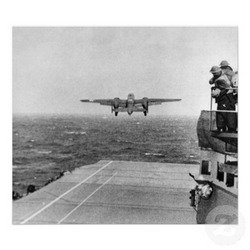
On
June 6, 1942, the Hornet again was engaged along with the carriers,
Enterprise and Yorktown, in the first American victory at Midway Island.
Japanese lost 4 of its top of the line carriers out of a total of 6, but the crew of the
Yorktown was forced to abandon ship. A day later it was dispatched by a
Japanese submarine. One month earlier, May 8, the Lexington was sunk in the Coral Sea.
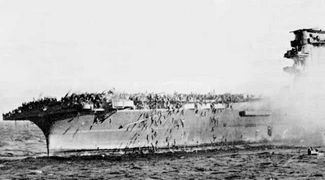
World War 2 Weapons and the navy
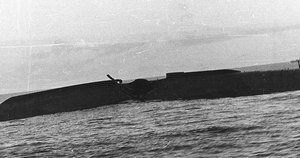
The Battle of the Coral Sea was the irrefutable evidence that the aircraft carrier had replaced the battle ship (June 3-6, 1942). This was the first sea battle when the opposing fleets never had eye contact. The respective air forces were the optical nerve for the opposing admirals.
We can point to the various successes engendered by the carriers, but their absence from a battle highlights their significance. On August 8, 1942, an American fleet was screening a marine force during the battle for Guadalcanal, an island in the Solomon chain. Their carrier support had been withdrawn. The Japanese fleet pounded the American ships with a loss of 2,000 American sailors.
The month of October found the opposing fleets constantly engaged. Japanese Rear Admiral Aritomo Goto was mortally wounded when his flag ship was severely damaged, but the aircraft carrier USS Hornet was sunk on October 27. Unfortunately, in the same engagement the USS Hornet was sunk. Another tragedy in that Battle of Cape Esperance was the loss of the Cruiser USS Juneau, and the death of the five Sullivan brothers along with other crew mates.
In June 1942, the Japanese invaded American territory, the Aleutian islands. They were dug in and put up fierce resistance against an American force supported by planes off an escort carrier that put an end to the enemy on islands just off the American continent (May 29, 1943.) How determined was the enemy? Rather than surrender, almost all left alive committed suicide.
By 1944, American aircraft carriers were operating in Japanese waters. Their planes regularly attacking Japan and Formosa. In 1945, the Americans had secured many land air bases and well within range of their heavy bombers.
What were the Germans up to? If they had any aircraft carriers, none appeared in battle. The United States currently has 10 operational aircraft carriers. Still important for regional conflicts, but now reliant on land based missiles replacing the airplane in a global conflict.
Submarines World War 2 Weapons and the Navy
In World War 1 (1914-1918), the submarine was so significant that it largely contributed to the United States entry into that war in 1917. It was again ascendent in World War2 weapon systems.
The World War 2 submarines eclipsed the older versions in size, height and speed. The range increased from 1,500 miles to 8,500 miles. Most importantly the depth went from 100 feet to 700 feet. The engine rooms operated on diesel fuel. Diesel required oxygen and hence the need to surface. The Germans, late in the war, used a partial Dutch solution. They ran slightly below the surface and extended an intake tube above the surface.
These compact compartments were models of efficiency and complexity. The Japanese engines produced the fastest and longest range boats.
World War 2 Weapons and the Navy
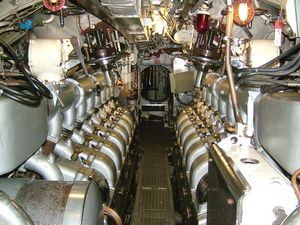
The submarines were deadly not only against enemy shipping but proved to be coffins for many crews. The United States lost 52 subs (with over 2,000 dead), Germans-785 subs, Italians-85, Japanese 130. In May 1943, German Admiral Donitz was forced to recall his Atlantic submarine fleet because they were being sunk at a rate of 20 per month over a period of five months. By wars end, 28,000 German submariners died, but accounted for 3,000 Allied ships.
German crew abandoned submarine after depth charge attack launched from American ship.
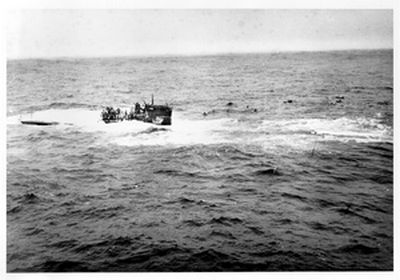
British submarines were also active. They sunk 2 million tons of shipping and 57 top of the line warships. But they were at risk every moment at sea. HMS Thorn sunk August 9, 1942. Below is a periscope view from the USS Wahoo sinking the enemy ship.
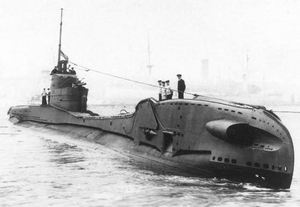
A periscope view from the USS Wahoo sinking an enemy ship.
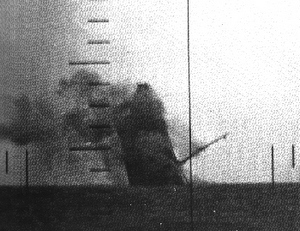
At the height of their effectiveness, German submarines hunted allied shipping in "wolf packs". A submarine would spot a convoy and radio submarines in adjoining zones, gather, and attack at night. In darkness, they might avoid detection from British or American anti submarine vessels. In contrast, American submarines generally operated singly and independently.
When measuring the losses against the havoc created, the weight of evidence supports the offensive value of the submarine. The World War 2 models carried more torpedoes and heavier deck guns than in World War 1. In European/Atlanic waters, deck guns often were used against unescorted merchant shipping, and at the same time provided surface time to recharge the submarine's batteries.
In measuring the technology of the torpedo, Japan's were best while the United States was poor and plagued with duds, premature explosions, running to deep and the horror of a circular route. By war's end, these problems had been solved.
The U.S. Mark XIV torpedo weighed over 3,000 lbs, 20 1/2 feet long with an explosive warhead twice the power of TNT. Its water cooled combustion chamber powered the torpedo to operate at about 50 MPH with a range of 4500 yards.
World War 2 Weapons and the Navy
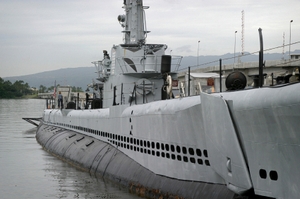
USS Bowfin
In the war in the Pacific zone, United States submarines crippled Japanese merchant shipping and destroyed their capacity for supplying their far flung armies. It was reliably estimated that 5 million tons of Japanese merchant vessels were sunk and 700,000 tons of naval vessels. These numbers are best viewed by the following statistics of Japanese life: in the course of the war, imports fell 50%, caloric intake of civilians fell to 12% of minimum daily requirement. Oil imports from August 1943 to July 1944 dropped from 1.75 million barrels of oil monthly to 360,000 barrels per month. When measured that loss against their naval oil requirements of 1.6 million barrels of oil per month, time was against the Japanese military.
For some unknown reason, The
Japanese submarines had no strategy to attack American merchant marine.
Their entire emphasis was on U.S. naval vessels.
The American
submarines sunk 8 Japanese aircraft carriers, 1 battleship and 11
cruisers, numerous smaller boats and contributed to the loss an damage
of many others in conjunction with other naval and air activities.They
had one advantage. The ability to intercept and decode Japanese messages.
The system was dubbed "magic".
The cost efficiency in the utilization of submarines is further illustrated by this estimate: The Japanese expended 42 times more for anti-submarine warfare than the cost of the entire American submarine fleet built during the war-- 288 boats in the Atlantic and Pacific. There is a similarity when compared with the German U boat menace. The Allies expended 10 times more to protect shipping than the cost of the Germans to build their 1000 plus U boat fleet.
Submarines were often used to deliver limited amounts of supplies. In 1942 when the Japanese were attacking Bataan in the Philippines, U.S. subs managed to bring supplies to the besieged on Corregidor Island, and also took on board, and rescued, Filipino President Manuel Quezon.
Each of the navies had several classes of submarines. In general there were three classes: smaller, coastal when submerged displaced about 260 tons, medium displaced about 900 tons and the larger over 100 tons and up. However, there was a fourth class, the mini submarine. Almost all of the navies (other than the United States) had these small boats that generally crewed one or two sailors. Germany built 285 for two man crews that carried a torpedo and was responsible for sinking at least nine ships, but lost 35 of these subs. The Japanese employed five mini's on December 7, 1941 when they attacked Pearl Harbor. All were either captured or sunk.
The Japanese sneak attack strategy was not completely successful in Pearl Harbor. Their dive bombers overlooked the United States submarine pens and maintenance facilities.
World War 2 Weapons and the Navy
World War 2 Weapons and the Navy
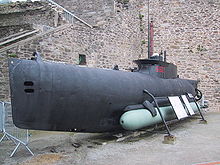 German |
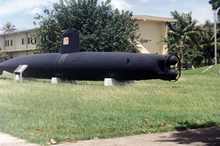 Japanese World War 2 Weapons and the Navy |
Mines on land an sea were endemic. Submarines distributed their share and many times that resulted in sinking friendly vessels. For the most part they were planted in waters and left uncharted. In 1944, allied infantry suffered casualties off the Anzio beaches when their boats struck mines.
Mine sweepers were vessels designed specifically to locate and detonate mines. They were steel hulled and 95 were operative. They were 221 feet in length, crew of 100 and armed with 50 caliber guns, 2 depth charges and Bofar guns to protect against air attack. Six were lost by enemy attack-one sunk by a U-Boat.
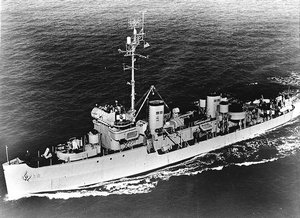
Small Naval Boats
In the early years of the 20th century, motor boat racing attracted the attention of European and American navies. The attraction was speed. Small, fast naval craft were used sparingly in World War 1 navies. The British were already cognizant of the value of small, fast boats for air/sea rescue and the Americans recognized their value for their defensive value along the country's long coast lines. General Douglas MacArthur favored them for the same reason in the Philippine Islands to shore up the American military presence. As war broke out on December 7,1941 their were 6 motor torpedo boats moored in Manila Bay. MacArthur ultimately was evacuated from the falling Philippines in one of these craft. They were already part of the lend lease package to Great Britain and, in a later plan, part of the force to be used in the invasion of Japan. They also saw service in the Mediterranean Sea used against enemy merchant vessels.
As World War 2 began, many navies, particularly those that would ally with Great Britain were in short supply of capital ships. To fill the temporary gap, the United States attention shifted to the small boats. In 1938, Franklin Delano Roosevelt, 32nd president, had served as an assistant secretary of the navy. As President, he took particular interest in the small. speedy boats and requested congress to appropriate 15 million dollars for their construction. On December 7, 1941, a squadron (Squadron 1 part of 3 squadrons in the Pacific) of 12 patrol torpedo boats (PT Boat) were anchored in Pearl Harbor. Their 50 caliber machine guns were active against the Japanese planes. One of their 101 inch slugs struck a Japanese torpedo plane ("Flying Kate") that crashed in flames.
The boats were 77 feet long (to grow over 80 feet as the war progressed) and built by the Electric Boat Company of Bayonne, New Jersey. The boat was an all laminated wooden craft (marine plywood covering), fast at 40 knots and agile. It had a radius of 240 miles, carried 2 machine guns, 2 torpedoes, and an anti aircraft gun. The boat was stepless constructed with a flat hull made for greater stability in rough water. The crews were made up of volunteers. In May of 1942, the sentiment for these boats was thus expressed:
"With daring and fearless young naval officers------there is nothing but trouble and defeat ahead for the enemy------we need more of these boats".
This statement might easily have been made years after the public learned of the exploits of a young naval officer, John F. Kennedy, commander of Pt boat 109.
World War 2 Weapons and the Navy
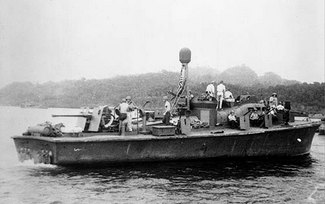
World War 2 Weapons and the Navy
World War 2 Weapons and the Navy
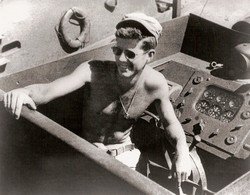 |
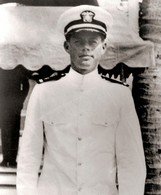 |
World War 2 Weapons and the Navy
World War 2 Weapons and the Navy
The amphibious landing craft saw service in every theater of war. This was part of the arsenal of all the major military services. In the United States, they were under the command of the ground forces---be they marines or army.There were 80 distinct models used by all militaries. Most were self propelled. with exception of some landing barges.
Some of the self propelled boats had wheels (DUKW). These vehicles were first used in the American invasion of Sicily July 1943. 20,000 of these "boats" were manufactured by the United States. They were capable of carrying 5,000 pounds of cargo and 25 armed men. They were armed with machine guns. The bow of almost all amphibious craft had a ramp for easy off landing and loading.
World War 2 Weapons and the Navy
World War 2 Weapons and the Navy
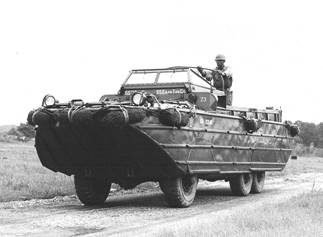
These boats had flat bottoms that could ride up onto beaches, Some carried rockets and sophisticated navigational instruments necessary for night time attacks.The best known are the landing craft used for the Normandy invasion (June 6, 1944). Some, like the LTV, carried large equipment onto the beaches.
World War 2 Weapons and the Navy
World War 2 Weapons and the Navy
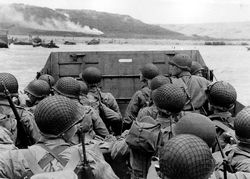 |
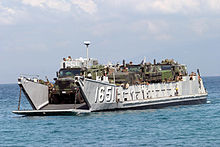 r World War 2 Weapons and the Navy World War 2 Weapons and the Navy
|
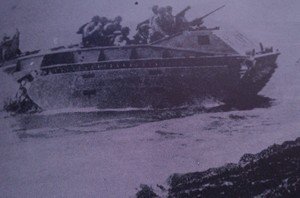
August 7, 1942: Americans land in the Solomon Islands
World War 2 Weapons and the Navy
_____________________________________________________________________
World War 2 Weapons and the Navy
Part 1: World War 2 Weapons
Part 2 : World War 2 Aircraft
Sources and references:
Budianski, Stephen. U Boats, Torpedoes, Blackett's War, Alfred A. Knopf, New York 2013.
Cross, Robin. The Bombers,Grub Street, 1987.
Ellis, John. Brute Force.Viking, Penguin 1990
Encyclopedia of World War II. John Keegan, Ed, Rand McNally, New York 1977.
Goralski,Robert. World war II Almanac, 1931-1945, G.P. Putnam's Sons, New York
History Learning Site
Hoyt, Edwin P. Carrier Wars. McGraw Hill Publishing, New york 1989.
Hughes, Terry, Corletti, John. The Battle of the Atlantic. The Dial Press New york 1977.
Johnson, Frank D. United States PT Boats of World War II, Bedfrod Press, Poole-Dorset 1980
Learning Site
Lucas, James. Panzer Army Afrika, Presidio Press, Cal 1977.
Messinger, Charles. Chronological Atlas of World War II. Bloosburg Publishing LTD, MacMillan Publishing, NY 1989.
Military Factory.com
Montague, Ewen. Beyond Top Secret Ultra. Britain 1977.
Neilands, Robin. The Bomber War. Overland Press, Woodstock, New York 2001.
The Library of Congress World War II Companion, David M. Kennedy, Ed. Simon & Schuster, New York 2007.
.
American Wars | Causes of World War 2 | World War 2 Weapons and the Navy